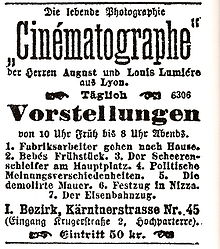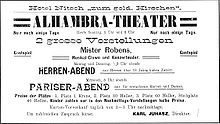Cinema of Austria
| Cinema of Austria | |
|---|---|
 The Gartenbaukino in Vienna during the Vienna International Film Festival 2010 | |
| No. of screens | 577 (2011)[1] |
| • Per capita | 7.6 per 100,000 (2011)[1] |
| Main distributors | Uip 17.6% Warner Bros. 16.4% Constantin 14.4%[2] |
| Produced feature films (2011)[3] | |
| Fictional | 35 |
| Animated | - |
| Documentary | 19 |
| Number of admissions (2011)[5] | |
| Total | 15,752,844 |
| • Per capita | 1.98 (2012)[4] |
| Gross box office (2011)[5] | |
| Total | €124 million |
Cinema of Austria refers to the
Between the two World Wars, directors like
The 1950s brought Austria the largest film production boom in its history, but without a
With national subsidy arriving in 1981, a new generation of Austrian filmmakers established themselves at home and international festivals in the 1980s and 90s, among them Axel Corti, Niki List, Paul Harather, Michael Haneke, Barbara Albert, Harald Sicheritz, Stefan Ruzowitzky and Ulrich Seidl. In the first decade of the 21st century, Austrian cinema found its long-delayed New Wave and international critical success.
Austrian or Austrian-identifying actors who have achieved international success from the 1920s to the present include
History
Before 1918


| Cinema of Austria |
|---|
 |
|
List of Austrian films |
| 1907-1919 |
| 1920s |
| 1930s |
| 1940s |
| 1950s |
| 1960s |
| 1970s |
| 1980s |
| 1990s |
| 2000s |
| 2010s |
| 2020s |
| Austrian film actors |
| Austrian film directors |
Between 1896 and about 1905 the only films produced in Austria were
Mainstream film production began in 1910 when the company "Erste österreichische Kinofilms-Industrie" (later Wiener Kunstfilm) was founded by Anton Kolm, his wife Luise Kolm, and Jacob Fleck. They started with newsreels but soon began to produce fiction films. In 1912 Count Sascha Kolowrat-Krakowsky, a wealthy nobleman from Bohemia, founded the Sascha-Film company. In the period before 1918 it grew into the largest production company in Austria; its main competitor was Wiener Kunstfilm. After the start of World War I the Austrian film industry grew in strength, as many foreign companies, including those of France's powerful film industry, were no longer allowed to produce or distribute films in Austria. In the period 1914 to 1918, nearly 200 movies were produced in Austria - twice as many as in all the years before.
Some Austrian filmmakers had already emigrated and begun careers in the United States by this time.
1918 to 1936
After the end of World War I, film production continued to grow, because the then Austrian currency, the Krone, was very weak. As a result, Austrian films were cheaper than those from other countries. In the years 1919 to 1922 Austrian film production reached its all-time peak with a yearly output of 100 to 140 films.
Many of the films produced in this period were of a lower quality than those of established film-producing nations like France, Great Britain, Denmark, Germany and Italy. But among the mass of low-grade productions there were also films by producers and directors who attached importance to quality. Consequently, the
Around 1923 the whole European film industry went into decline due to growing competition from the United States. American films could be exported to Europe very cheaply, because the production costs had already been earned back at the American box-office. The European film industry, divided into many different countries and many different languages, could not produce quality films at a low enough price to compete with the American imports. Another issue which affected Germany and Austria was the successful reining in of hyperinflation. Austrian films were no longer especially cheap and exports fell. As a result, Austrian film production had reduced by the mid-twenties to between 20 and 30 films per year, a level commensurate with its new greatly reduced size after World War I. In the whole silent movie era around 1,000 films were produced in Austria.
The 1920s were also the age of the
Between 1933 and 1936 Austria was a refuge for many German filmmakers who had emigrated from Nazi Germany, among them directors Erich Engel and Werner Hochbaum.
1936 to 1945
Although Austria was not annexed by Germany until 1938, Jews were forbidden to work in the Austrian film industry from 1936 onwards due to pressure from Nazi Germany where Jews had been banned from film work within months of the Nazis taking power. Germany was the most important export market for Austrian films and Germany had threatened a total ban on Austrian film imports unless the Austrians complied with their demands. The only exception to this ban was, for unknown reasons, the film
After the
The whole Austrian film industry was quickly integrated into one company Wien-Film, which was the new name of Sascha-Film following its confiscation by the Nazis with the help of the Creditanstalt bank. Wien-Film produced few openly propagandistic films; the majority of its output was apparently harmless comedies, which often had an antidemocratic and anti-semitic subtext. Although Nazi censorship was strict, a few films contained criticism hidden at a metaphorical level, for example the musical comedies of Willi Forst.
1945 to 1970
The period between 1945 and 1970 was the age of musical comedies, which had already become popular in the 1930s, and of
1970 to 1990 − era of structural changes
The 1970s was the period in which Austrian film production reached its lowest ebb with only five to ten films being produced each year. The reactionary Austrian film industry succumbed to the rise of television whilst at the same time, a new, young, and critical generation of filmmakers - the Austrian avant-garde movement - emerged with productions that were often experimental. Notable avant-garde filmmakers, some of whom had begun working in the late 1950s, included Peter Kubelka, Franz Novotny, Ernst Schmid Jr., Ferry Radax, Kurt Kren, Valie Export, Otto Muehl, and Peter Weibel.
By around 1980 a new wave of mainstream film production had begun in Austria. With the modern industry having to compete with leisure pursuits like television and computers which did not exist in its heyday of the interwar period and the 1950s, a return to the production levels of those times seems most unlikely. However, the Austrian industry did begin to rediscover different film genres which had been largely forgotten from the 1930s through to the 1960s when sentimental comedies dominated the domestic scene. Whilst comedies remain popular in Austria to this day, the nature of the comedy has changed and dramas have returned to popularity. Other genres such as the
After 1990 – new generation
| cinema-film production | |||||||
| Year | Amount | ||||||
|---|---|---|---|---|---|---|---|
| 2000 | 17 | ||||||
| 2001 | 12 | ||||||
| 2002 | 26 | ||||||
| 2003 | 20 | ||||||
| 2004 | 24 | ||||||
| 2005 | 24 | ||||||
In the 1990s, the Austrian film industry underwent a number of structural changes. Some directors, both established and upcoming have created their own film-companies to share resources and learn from each other. The other film companies, the biggest of which are Dor-Film and Allegro-Film, both producing at least two theatrically released films a year, concentrate on commercially oriented productions such as comedies with cabaret stars who enjoy a high profile in the Austrian market. Such comedies, notably Hinterholz 8 and Poppitz, both directed by Harald Sicheritz, have had the highest box-office of any Austrian films in the last 25 years. These companies also produce more challenging films, but only in limited numbers as productions other than comedies are financially risky in Austria unless foreign distribution can be secured.
Austrian films' share of the domestic box-office is one of the lowest in Europe, with only about 3% of cinema admissions going to domestic productions. Every year the annual top ten films at the Austrian box-office are usually all American.
High-quality Austrian films, which have won more and more critical acclaim in recent years, are usually produced by small production companies, often in co-production with other countries. Examples of this are
Contemporary Austrian film making is internationally well known for its realistic social dramas, which enjoyed high attention and many awards on international film festivals since the late 1990s. On the occasion of a film row of Austrian films in the
The Holocaust narrative
Organisations
The Austrian Film Commission (AFC) supports promotion and export of Austrian films. This organisation is the Austrian member of European Film Promotion (EFP), a European-wide network aiming at the worldwide promotion of European film.
Films
Directors
Actors
See also
- Filmmuseum Austria
- Cinema of the world
Bibliography
in English:
- ISBN 978-1-84545-700-6
- ISBN 0-7864-2078-2
- Eleonore Lappin: Jews and film = Juden und Film: Vienna, Prague, Hollywood. Institut für Geschichte der Juden in Österreich, Vienna 2004, ISBN 3-85476-127-9
- Ernst Schürmann: German film directors in Hollywood: film-emigration from Germany and Austria: an exhibit of the Goethe Institutes of North America. 1978
- Modern Austrian Literature: Special issue: Austria in film. International Arthur Schnitzler Research Association, Riverside (Ca.) 1999
in German:
- ISBN 3-85449-090-9.
- Francesco Bono, Paolo Caneppele, Günter Krenn (publisher): Elektrische Schatten, Verlag Filmarchiv Austria, Vienna 1999, ISBN 3-901932-02-X
- Walter Fritz: Im Kino erlebe ich die Welt: 100 Jahre Kino und Film in Österreich. Verlag Christian Brandstätter, Vienna 1997, ISBN 3-85447-661-2
- Ulrich, Rudolf: Österreicher in Hollywood. [Austrians in Hollywood] Filmarchiv Austria, Vienna 2004, 623 pages, ISBN 3-901932-29-1(available in German only)
References
- ^ a b "Table 8: Cinema Infrastructure - Capacity". UNESCO Institute for Statistics. Archived from the original on 5 November 2013. Retrieved 5 November 2013.
- ^ "Table 6: Share of Top 3 distributors (Excel)". UNESCO Institute for Statistics. Archived from the original on 16 September 2013. Retrieved 5 November 2013.
- ^ "Table 1: Feature Film Production - Genre/Method of Shooting". UNESCO Institute for Statistics. Archived from the original on 23 March 2014. Retrieved 5 November 2013.
- ^ "Country Profiles". Europa Cinemas. Archived from the original on 9 November 2013. Retrieved 9 November 2013.
- ^ a b "Table 11: Exhibition - Admissions & Gross Box Office (GBO)". UNESCO Institute for Statistics. Archived from the original on 3 November 2013. Retrieved 5 November 2013.
- ^ The New York Times, Dennis Lim, November 27, 2006 (article online)
- imdb.com, Awards for Fälscher, Die ([1])
